Jerzy Kawalerowicz’s Pharaoh (Faraon) is a state-funded superprodukcja, a 152-minute Polish epic, set, incongruously, in Ancient Egypt. First released in 1966, it wasn’t intended to be an Eastern Bloc copy of Mankiewicz’s Cleopatra; Pharaoh is an altogether darker, more sober work.
Based on a popular 1895 novel by Bolesław Prus, Kawalerowicz’s screenwriting partner Tadeusz Konwicki saw the story as “a penetrating analysis of a system of power” rather than a straightforward historical novel. Polish cultural officials stressed that Pharaoh should be spectacular; what’s striking is how the visual thrills co-exist alongside weightier matters.
Newcomer Jerzy Zelnik plays the fictional Rameses XIII, a charismatic, ambitious leader whose efforts to reform his country are constantly undermined by Egypt’s religious elite. Encroaching desert is causing water shortages, the country’s borders are becoming porous and the gap between rich and poor is growing. Kawalerowicz opens his film with an extended closeup of two sacred beetles rolling a ball of dirt; rather than disturb the insects, the clergy order Rameses’s army to advance around them, wrecking a freshly built irrigation canal and prompting the suicide of a labourer who’d worked on it. Rameses’s main antagonist is Herhor (Piotr Pawłowski), imposing but slippery, determined to maintain the status quo and prevent war with neighbouring Assyria. Rameses finds some comfort in a relationship with his Jewish mistress Sarah (Krystyna Mikołajewska), the pair’s future later undermined by Barbara Brylska’s sultry priestess.
 The set pieces are stunning, from the opening tracking shot following a running soldier to a gruelling battle sequence. An angry crowd is subdued by a solar eclipse, and Rameses comes to a sticky end. You’ll forgive an unconvincing subplot involving Rameses’s double and the paucity of female characters, instead marvelling at the film’s sheer strangeness and audacity, enhanced by Adam Walaciński’s spare score.
The set pieces are stunning, from the opening tracking shot following a running soldier to a gruelling battle sequence. An angry crowd is subdued by a solar eclipse, and Rameses comes to a sticky end. You’ll forgive an unconvincing subplot involving Rameses’s double and the paucity of female characters, instead marvelling at the film’s sheer strangeness and audacity, enhanced by Adam Walaciński’s spare score.
This Egypt is parched and oppressive, the colour palette deliberately muted (“we wanted to limit the opulence and glitter of antiquity and show Egypt as it perhaps really was”). Red, blue and green were avoided, the production design emphasising ochre, white, black and gold. Much of Pharaoh was shot in Uzbekistan’s Kyzylkum Desert, cast and crew contending with temperatures of 60 degrees Celsius alongside snakes and poisonous spiders. 10,000 bottles of fresh water were reputedly shipped in each day, the cameras wrapped in sheets to protect them from sand, the film canisters refrigerated to prevent their contents melting in the heat. Thousands of extras were hired, battle scenes augmented with legions of unpaid conscripts from the Uzbek army.
This 2K restoration looks and sounds good, and Second Run’s presentation is exemplary. Michael Brooke’s long booklet essay is informative and entertaining, and extras include a clip from a 1964 newsreel showing Kawalerowicz and crew on location in Uzbekistan. Plus an excellent, extended Afterword from Polish critic Michal Oleszczyk, especially interesting when explaining how Pharaoh’s anti-clerical subtext would have pleased the Polish communist authorities. Definitely one of my films of the year.














Add comment